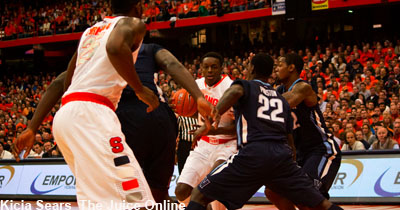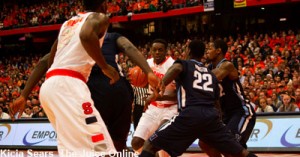
The 2014 NBA draft has been in the books long enough that the ink is dry, the grades are in, and the league itself has already shifted into “OMG, free agency” mode. We should not, however, let the draft move too far away without trying to note some things for next year, particularly as these lessons pertained to the Syracuse players who were drafted.
When Tyler Ennis declared for the draft on March 27, the initial projections had him listed as a mid- to late lottery selection, generally in the #8 to #14 range of the draft. He ended up being selected #18 by Phoenix, which is not a great fall by any sense. How was he bypassed, though?

Well, one reason is the NCAA Tournament was not yet fully in the bag, as Ennis declared the day the Sweet Sixteen was set to get underway. Four underclassmen who were still playing in the tourney and not shoo-ins to declare for the draft (Nik Stauskas, Elfrid Payton, Zach LaVine, and James Young) ended up being selected before Ennis. All four of those players declared in mid-April or later.
Payton, in particular, helped push Ennis down in the draft by providing direct competition as another point guard. Payton, who played for Louisiana-Lafayette, is a little bigger than Ennis and also has a reputation as a strong defensive player, as evidenced by him being the recipient of the Lefty Driesell Award as the best defensive player in college basketball.
» Related: Ennis believe he’s a good fit with Phoenix
Payton’s stock also rose through workouts leading up to the draft, highlighted by his athleticism and how he reportedly performed in interviews with NBA executives.
Lesson to remember for next year #1: It is best to wait until close to the deadline to declare to get an accurate read on a player’s draft stock. The initial projections for Ennis were simply made before the draft pool was complete. It would be best to hedge on draft projections unless a player is simply acknowledged as one of the top talents available.
Ennis’ SU teammate, Jerami Grant, did wait to declare for the NBA draft, not throwing his hat into the ring until April 14. Early response to Grant’s move was favorable, as Grant’s raw athleticism, length, and motor outweighed his raw offensive game in the eyes of most analysts, who generally declared him a late first-round pick.
As draft night approached, however, many experts cooled on Grant, citing his poor perimeter shooting, ballhandling, and passing as reasons not to take him. Grant slid out of the first round, eventually settling to a landing spot at #39 with the Philadelphia 76ers.
While Grant’s draft stock was sliding, something important was happening in NBA games. The San Antonio Spurs were decimating the Miami Heat in the NBA Finals with exquisite passing and shooting up and down the roster.
» Related: Jerami Grant falls to the second round
Lesson learned for next year #2: The NBA is a copycat league. (Okay, you’re not really learning this if you are a professional sports fan.) With the heightened importance of perimeter shooting in the NBA in the last few years, including the growth in importance of the “stretch four,” any player of Grant’s skill set would be hard-pressed to land in the first round of the draft. In addition to shooting, passing and driving ability have proven to be valued commodities in the NBA and they should remain that way until the next wave sweeps the league.
Lesson learned for next year #3: The teams that draft late in the first round are looking for players who can fill a role immediately, as they are contenders. Setting aside the two European players who are not expected to play in the NBA this coming season, the players selected in the last third of the draft’s first round are players that have one elite skill that is expected to translate to the NBA, in most cases immediately. From Rodney Hood’s shooting to Shabazz Napier’s point guard skills to Kyle Anderson’s passing to even the defensive chops of Josh Huestis, the players chosen in the last ten picks of the first round are expected to be role players soon. Players expected to fall in that #21 to #30 range should be able to be on an NBA floor right away.
For more Syracuse coverage, Like our Facebook page and follow us @TheJuiceOnline.

